In 1911, two huge personalities and historic ships raced to be the first to lead an expedition to the South Pole.
And artist and archivist Michael Durning, inspired to celebrate Scots explorers by researching them at the Royal Scottish Geographical Society (RSGS) in Perth, has discovered that the origins of one of those vessels began in the Fair City itself.
A discovery unknown to most of the world – until now.
Michael said: “I discovered an oddly named Norwegian called Colin Archer during my art project: commemorating the centenary of the death of Scotland’s ‘Forgotten Polar Explorer’, RSGS’s own William Speirs Bruce.
“Mapping a trail that began at the Paisley Art Institute’s Art Collection and circumnavigating polar history, I arrived in Perth.”
Colin was born in Larvik, Norway in 1832 to Perth parents who had emigrated to the country seven years before, leaving behind a home they built in Canal Street.
Young Colin became an innovative boat builder and committed himself to the fledgling Norwegian lifeboat organisation.
Established along the coast of Norway, his new boats immediately changed the lives of the country’s mariners.

One of his rescue boats alone saved 329 lives and assisted 102 ships, and in recognition Colin was made a Knight of the Order of St Olaf.
As a result of his great nautical creations, Nobel Prize-winning explorer Fridtjof Nansen asked Colin to design a polar ship for his 1893 Arctic expedition.
Colin then designed and built the ship, donning it “Fram”, meaning Forward, in 1892 which was labelled a wonder of the ‘Heroic Age’ as it could defy lethal icey conditions with its retractable propeller and rudder.
Its rotund hull meant that when large swathes of ice threatened to submerge the ship, its buoyancy could pop it up above the water’s surface.
The ship also managed to keep the crew warm during sub zero expeditions due to electricity generated by an inspired wind turbine.
The vessel was heralded and ventured on Arctic and Antarctic expeditions with Norwegian explorers Otto Sverdrup and Oscar Wisting.
But Fram’s finest moment would arrive in late 1911.
The ship, taken command by famed Norwegian explorer Roald Amundsen, was pitted in a historical challenge against Briton Robert Falcon Scott’s Dundee-built ‘Terra Nova’ - to become the first expedition to reach one of the last great geographic goals of the age, the South Pole.

This ‘Great Tay Boat Race’ was a perilous journey covering over 10,000 miles of stormy waters and merciless ice sheets and glaciers.
The journey would end in victory for Amundsen – and tragedy for Scott.
After months at sea, Captain Scott reached the South Pole on January 17, 1912 with he and his crew believing they had made history – only to be welcomed by the sight of a Norwegian flag that had arrived a full month earlier.
Fram had reached the Ross Ice Shelf on January 14, 1911 with the Norwegian having chosen to land at the Bay of Whales.
This gained Amundsen a 60-mile advantage over Scott, who chose to land at McMurdo Sound.
The Fram shipmates then trekked and camped in merciless conditions for months before arriving at their final Antarctic destination on December 14, 1911.
Disappointed to learn that Amundsen had beaten him to it, Scott’s return journey was faced with stoicism and dignity.
However he and his crew were weak from exhaustion, hunger and extreme cold, with his last diary entry dated on March 29, 1912.
He died in his tent alongside two of his men.
Amundsen’s team managed to safely make their way off the continent to Hobart, Australia, where he publicly announced his success on March 7, 1912.
He and Fram were celebrated worldwide, receiving personal telegrams of congratulations from US President Theodore Roosevelt and King George V of England.
Scott was also recognised for his achievements and posthumously made a Knight Commander of the Order of the Bath.
The seismic achievement made Fram and Colin Archer history makers and, in an odd coincidence, Michael’s discovery arrived just in time for the 150th birthday of Amundsen in 2022.
Asle Toje, deputy leader of the Nobel Prize Committee of Norway, said that Colin Archer is a “national hero” to Norway and to Scotland. “He is to Norway what Isambard Kingdom Brunel is to Britain,” he added. “Scotland should be proud of its famous son.”
Fram’s success became the embodiment of Norwegian pride, the ship that sailed the furthest north and furthest south of any other in history - making it perhaps among the strongest wooden ships ever built.
Only polar ships Fram and Dundee’s Discovery have survived to this day, with the former now preserved as a museum ship at the Fram Museum in Oslo.
Both travelled to the ends of the earth but their histories are linked by the water of the silvery Tay, separated by a distance of only 22 miles.







